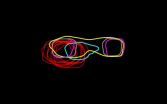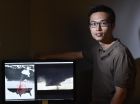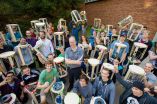(Press-News.org) This election year has produced 17 Republican presidential candidates, which on its surface may appear to give the party a competitive advantage. Evolution, however, disagrees.
A new study by Michigan State University researcher Arend Hintze and appearing in the current issue of Scientific Reports, says the delicate balance of some, but not too much, competition optimally drives the evolution of decision-making strategies.
"Competition has a unique relationship with our decision-making strategies as humans," said Hintze, an assistant professor at MSU. "Modest competition is a strong driver of good decision-making, but over-competition won't lead to the best outcome."
Hintze found that strong competition, like that of the presidential candidate field, may cause humans to evolve quick decision strategies that sacrifice accuracy in order to be faster to the punch than competitors. Weaker competition, however, causes humans to evolve decision strategies to become more thoughtful and to do more research when seeking answers.
"More competition necessitates quicker, less accurate decisions," he said. "To prevent competitors from choosing first, we may rely on minimal information to make a decision. The downside of this strategy is the risk of ending up with the inferior option."
Away from the presidential spotlight, hermit crabs are constantly using this evolutionary skill. As the they grow, they need new, larger shells. In areas with a small crab population, crabs will inspect new shells carefully, even trying them on before committing to a new home.
More crabs mean more competition. In crowded areas, crabs come across new shells and make snap decisions to wear them. Some crabs even cling to others before they shed their shells to lay claim to them. Hintze found that this excessive competition drives the evolution of split-second decision-making, even if that decision is not the most beneficial.
In the race for the presidency, this might be seen in quick-response decisions or reactions as candidates fight for media coverage and relevancy. The strong competition might push candidates to comment on a topic or issue without proper planning because they are driven to mention it before their competitors. This drive is the adaptive result of evolution, according to Hintze.
"Making quick decisions in light of competition is not irrational," he said. "It's the sign of an evolved organism to know when to rely on a hunch, even though the hunch might not be the best choice."
Thus, in order to get the best possible candidate for the presidential election, and to focus more on the topics that matter, the candidates should compete with one another less for the best results, he added.
INFORMATION:
This interdisciplinary study is a collaboration between Hintze's Artificial Intelligence research lab at MSU, Ralph Hertwig, Center for Adaptive Rationality at the Max Planck Institute for Human Development, and Nathanial Phillips of the University of Konstanz Germany.
An overview of regulatory solutions worldwide on the use of nanotechnology in food and feed production shows a differing approach: only the EU and Switzerland have nano-specific provisions incorporated in existing legislation, whereas other countries count on non-legally binding guidance and standards for industry. Collaboration among countries across the globe is required to share information and ensure protection for people and the environment, according to a JRC co-authored paper.
The paper Regulatory aspects of nanotechnology in the agri/feed/food sector in EU and ...
The list of potential mechanisms that underlie an unusual metal-insulator transition has been narrowed by a team of scientists using a combination of X-ray techniques. This transition has ramifications for material design for electronics and sensors.
The transition between being electrically conductive (metallic) at high temperatures and electrically insulating at lower temperatures is known as a metal-insulator transition (MIT). Pinpointing the activation mechanism that allows crystals used in devices such as transistors in electronics and temperature-based sensor control ...
The light that typically floods homes, offices and public buildings could provide something more than illumination. Scientists at Disney Research and ETH Zurich have demonstrated that light could be a medium for light bulbs to communicate - with each other, with objects and with the Internet.
Transmitting signals via light is nothing new; Alexander Graham Bell showed that speech could be conveyed with light in the 1880s, years before speech was first transmitted via radio. The Disney researchers, however, have created networking technology that makes it possible for LED ...
KANSAS CITY, MO -- Cellular mitosis depends in part on small organelles that extend spindles to pull apart chromosome pairs. Before they can perform this and other essential tasks, these tiny cylindrical structures -- known as centrioles in animals and spindle pole bodies (SPBs) in yeast -- must themselves duplicate.
However, much about this nanoscale process has remained veiled by the limits of current microscopy. Optical approaches cannot resolve objects below certain wavelength limits, while non-optical approaches like electron microscopy (EM) can only study nonliving ...
What if tornado activity could be forecasted months, even seasons in advance? Thanks to a new model developed at the University of Toronto Scarborough, that ability could soon become a reality.
"The aim is to predict ahead to the following year or subsequent years about whether we'll get above or below average tornado activity in a given area," says Vincent Cheng, a postdoctoral fellow in UTSC's Ecological Modelling Lab.
The model, developed by Cheng, Professor George Arhonditsis and Professor Bill Gough in UTSC's Climate Lab along with colleagues at Environment Canada, ...
Genetic mutations called "escape variants" in the deadly Ebola virus appear to block the ability of antibody-based treatments to ward off infection, according to a team of U.S. Army scientists and collaborators. Their findings, published online this week in the journal Cell Reports, have implications for the continued development of therapeutics to treat Ebola virus disease, which has claimed the lives of over 11,000 people in West Africa since last year.
Ebola virus overruns the immune system, thus overwhelming the host's ability to fight off the infection. One strategy ...
PhD candidate Matt Shultz has discovered the first massive binary star, epsilon Lupi, in which both stars have magnetic fields. A binary star is a star system consisting of two or more stars, orbiting around their common centre of mass.
For the past few years, the BinaMIcS (Binarity and Magnetic Interactions in various classes of Stars) collaboration, formed to study the magnetic properties of close binaries, has been trying to find such an object. They have now discovered one using the Canada-France-Hawaii Telescope.
"The origin of magnetism amongst massive stars is ...
LEXINGTON, Ky. (Sept. 8, 2015) -- A new University of Kentucky study in the journal mBio shows that tissue cysts of the parasite Toxoplasma gondii, long thought to be dormant, are quite active.
Led by Anthony Sinai, professor at the UK College of Medicine, the study has significant implications on the understanding of chronic toxoplasmosis in the brain, a condition suggested to contribute to a range of neurological diseases including schizophrenia in humans, and the modulation of behavior in rodents.
Toxoplasmosis can be acquired from the droppings of infected cats ...
Using metallic osmium (Os) in experimentation, an international group of researchers have demonstrated that ultra-high pressures cause core electrons to interplay, which results in experimentally observed anomalies in the compression behavior of the material.
Os is one of Earth's most exceptional elemental materials, possessing the highest known density at ambient pressure, one of the highest cohesive energies and melting temperatures, and an incompressibility that is almost comparable to that of diamond.
Researchers believe that the ability to affect core electrons ...
Open source lab equipment is the focus of a new study, published in Science and Public Policy. Joshua Pearce, an associate professor of materials science and engineering as well as electrical and computer engineering at Michigan Tech, led the research. Pearce proposes that instead of spending millions of dollars every year replacing quickly obsolescent equipment, that money could be redirected to developing open source tools that are "upgradeable and transformable--they will be continuously updated" using digital manufacturing techniques such as 3-D printing.
The benefits ...


